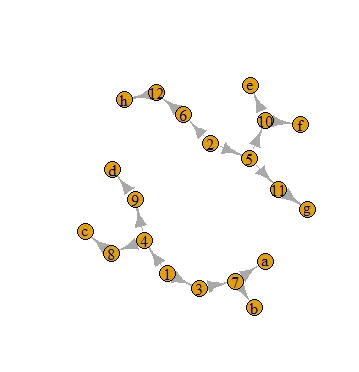我不太清楚如何解释,但是...
我有一张稀疏表格,其中每组代表一个级别。列是有序的,也就是说,下游(左侧)列代表子节点,上游(右侧)列代表父节点。
我想要一个两列表格,第一列是父节点,第二列是子节点。如果可能的话,第三列是父节点的长度(最终节点数的总和)。
请看以下示例:
>tt <- tibble(
ID = letters[1:8],
`1` = c( 1, 1, 1, 1, 2, 2, 2, 2),
`2` = c( 3, 3, 4, 4, 5, 5, 5, 6),
`3` = c( 7, 7, 8, 9,10,10,11,12)
)
> tt
# A tibble: 8 x 4
ID `1` `2` `3`
<chr> <dbl> <dbl> <dbl>
1 a 1 3 7
2 b 1 3 7
3 c 1 4 8
4 d 1 4 9
5 e 2 5 10
6 f 2 5 10
7 g 2 5 11
8 h 2 6 12
>dput(tt)
structure(list(ID = c("a", "b", "c", "d", "e", "f", "g", "h"),
`1` = c(1, 1, 1, 1, 2, 2, 2, 2), `2` = c(3, 3, 4, 4, 5, 5,
5, 6), `3` = c(7, 7, 8, 9, 10, 10, 11, 12)), row.names = c(NA,
-8L), class = c("tbl_df", "tbl", "data.frame"))
结果应该是:
>ttt <- tibble(
parent = c(1,1,2,2,3,4,4, 5, 5, 6, 7,7,8,9,10,10,11,12),
child = c(3,4,5,6,7,8,9,10,11,12, letters[1:8] ),
length = c(4,4,4,4,2,2,2, 3, 3, 1, 2,2,1,1, 2, 2, 1, 1)
)
>ttt
# A tibble: 18 x 3
parent child length
<dbl> <chr> <dbl>
1 1 3 4
2 1 4 4
3 2 5 4
4 2 6 4
5 3 7 2
6 4 8 2
7 4 9 2
8 5 10 3
9 5 11 3
10 6 12 1
11 7 a 2
12 7 b 2
13 8 c 1
14 9 d 1
15 10 e 2
16 10 f 2
17 11 g 1
18 12 h 1
> dput(ttt)
structure(list(parent = c(1, 1, 2, 2, 3, 4, 4, 5, 5, 6, 7, 7,
8, 9, 10, 10, 11, 12), child = c("3", "4", "5", "6", "7", "8",
"9", "10", "11", "12", "a", "b", "c", "d", "e", "f", "g", "h"
), length = c(4, 4, 4, 4, 2, 2, 2, 3, 3, 1, 2, 2, 1, 1, 2, 2,
1, 1)), row.names = c(NA, -18L), class = c("tbl_df", "tbl", "data.frame"
))
非常感谢您的帮助,提供的任何帮助都会受到赞赏。
提前感谢您的帮助。
